Elisée Reclus
Matriarchy and Patriarchy
from "Familles, Classes, Peuplades"
1905
The motive, that is to say the desire to please, which solicits each primitive individual to adorn his person, had the union of the sexes as a natural sanction, and, consequently, was to lead to the constitution of family groups. But, just as the ornaments varied according to the environments and the materials available to man, so the social forms determined by the union between the sexes have singularly changed in different places and in successive periods. In animals of various species, we find all modes of union; we also find them in the world of primitive men, in protohistory and in history itself: promiscuity without precise rule, practical community [communauté pratique] according to certain conditions, polygamy and polyandry, hierarchy of wives and of husbands, levirate, that is, imposed or optional inheritance of the woman left by an older brother; finally, temporary or permanent monogamy. However, one is easily led to immediately imagine a similar way of life for all those primitive men of whom no memory has remained to us, and who probably resembled the wild [sauvages] populations of our days, in which we observe a diversity of institutions. Thus, many sociologists admitted in a general way, but without any proof, that "the complete promiscuity of men and women, in the same horde, was the primordial state of our species." But why should this be so, since, beyond man, in the animal world, we see all forms of "gamy" appear, and, among these forms, several of them testifying to a mutual choice of individuals?
The experiments instituted by Darwin, and, since, by Houzeau, Espinas, Romanes and so many others, put beyond doubt that the "family" really exists, although under very diverse aspects, in the ancestral groups of the [age of] animality. We even find, in several species, examples of this monogamous family with constant and unalterable love that official moralists consider as having the sole right to the title of "marriage". However, it is certain that this kind of union is among the least common, and that the mixing of the sexes, apparently occurring in a capricious manner, is the most ordinary fact. It therefore seems quite probable that the same customs prevailed among most of the first men. In a distinct society, exposed to all dangers on the part of the members, the animals and the enemy tribes, the collective personality included all individuals, men, women, children, in such an intimate way that private property could not be constituted to separate them from each other: all were equally part of the big family.
As said by Oscar Browning,[1] there was certainly a period of history, in a large number of countries, where the appropriation of a woman by a man was considered an affront to society. Just as we have been able to repeat at all times, in memory of the seizure of the land by a few individuals, "Property is theft!", so we must have cried out "Marriage is kidnapping!”. The man who took the woman away from her fellow citizens to make her his own thing, his personal and private acquisition, could not be considered other than an abductor, a traitor to the community.
But, in such matters, the abrupt modifications of customs, the revolutions, must have been rather numerous. Passion does not adapt to traditional practices; rushing through, it transforms everything and ends up creating new institutions. Thus the brothers of the primitive horde, not daring to seize, on their personal account, a "sister", that is to say a woman belonging to their tribe, had no scruples to capture women in foreign tribes; often the lover, hidden in the bush, near the fountain where the young girl came to draw water, pounced on his prey to bring her in triumph to the native village, and possess her as sole master, not as an associate [sociétaire] husband.
It was the beginning of exogamic marriages, first carried out by force, by abduction, before assuming, by frequent recurrences, a normal character, accepted by all. Even today, there is no lack of countries where the kidnappings of young girls and women are carried out with real violence, without tacit complicity on the part of the victim or the parents. First, we must take into account the state of war that rages among so many human groups, in all parts of the world; when all impulsive passions are exasperated, when the life and liberty of the fellow human are at the mercy of whoever wants to take them, and the very arts of capture and murder are regarded as glorious and worthy of all praise, the perpetrator can feel fully in his rights to appropriate the captives: Achilles claims Briseis as his own, and, even among the so-called civilized nations, the soldier, delivered to the ferocious atavism of his instincts, arrogates to himself any license to rape as well as to looting.
But, among many primitive peoples who find themselves in a state of peace, either for a time or in a lasting manner, the practice of abduction of women remains nonetheless consecrated by custom. Thus, the Siah-Posh, or "Black-Robed", of the Hindu Kush, were strictly obliged, by tradition, to take a wife in a tribe different from their own; slipping near the hut where the coveted girl slept, the lover hurled a blood-tinged arrow there, ready, if necessary, to truly spill the blood of those who would stand in his way. This was also the case with the ancient Germans, who used the word brut-luft ’ (bride race) in the sense of marriage[2].
Likewise, in the Western Balkans, the Mirdita, or "Bon-Vivant", of Christian religion and republican manners, formerly used to consider as a dishonor not to have for wife a daughter taken from the Muslim of the plain, the hereditary enemy. The latter often valiantly defended his daughter or sister whom one sought to take away from him; but, knowing that the abduction of women was for the mountain people the rule of tradition, a "law of nature", he usually accepted with peace of mind the accomplished fact, all the more so since, at the time of one of those truces that interrupt, from time to time, the border wars, he could count, in an almost certain way, on the payment of a purchase price, fixed according to custom. In this case, the abduction has become the middle form between the primitive kidnapping and the simple purchase ― as it was once practiced among the Circassians of the Caucasus; ― this is where the more or less complicated ceremonies of money marriage [mariage d’argent] are derived from, which, by virtue of the conditions of property, is naturally the rule in the civilized societies of the European world.
If the real abduction still exists, how much more the traditional rites that testify to the primitive form of exogamic marriages![3] Examples of this survival abound in history. In Greece, in India, we remember the "heroic" marriage, the union practiced according to the so-called Rakchasa mode; in all parts of the Earth, tribes simulate the primitive form of kidnapping; the abduction of the Sabine women by the Romans is reproduced on all sides by games and festivals where swords are still drawn, where clubs are still brandished, but where blood is no longer spilled. We can even wonder if, by the effect of a continuous work of evolution, the groomsmen who, in current marriages, accompany the fiancés and the fiancées, do not represent, without knowing it, the armed people who, on both sides, once fought to conquer or keep the prey of love. But institutions, like peoples, have multiple origins: relics of hatred and relics of friendship are intertwined in a single drama in which the actors see nothing but pleasure. At all times, whatever may be said, mutual attractions must have directly given rise to the union between man and woman. A chapter of the Mahãbhãrata contains the description of all the legal modes of marriage, eight in number, and obviously responding to the customs of distinct nations which merged, at different ages, in the great crucible of Hindustan.
Map 33. Some forms of marriage in India
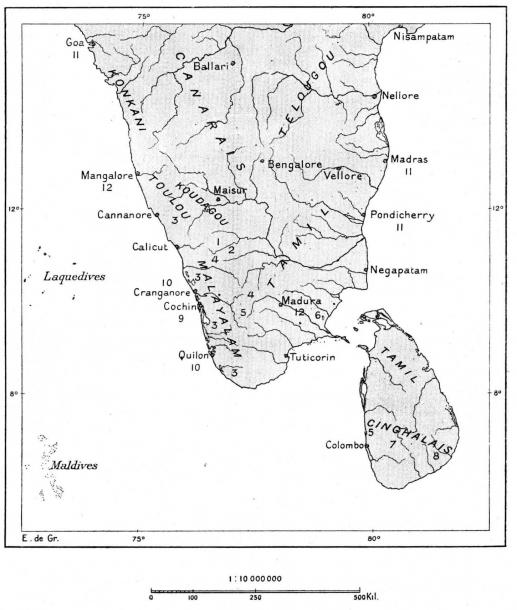
1. Toda, formerly polygamous marriages and the practice of infanticide. ― 2. Iroula, promiscuity. ― 3. Naïr, complex marriages of which matriarchy forms the basis. ― 4. Poliyar, polyandry. ― 5. Moplah, polygamy (Mohammedans). ― 6. Labbaï, polygamy (Mohammedans). ― 7. Rodiya, exogamic polyandry. ― 8. Veddah, marriage with the younger sister, endogamic polygamy. ― 9. Jews in Cranganore, strict monogamy. ― 10. Nazarenes in Quilon, religious monogamy. ― 11. Catholics in Goa, St. Thomas, Pondicherry, etc. ― 12. Protestants in Mangalore and Madura.
Tamil and Sinhalese, marriage by flowers.
The various forms of sexual union, from the regime of promiscuity to that of free contract by mutual consent, would remain misunderstood if we forgot that, in marriage, the child is the third term of the family trinity. It was he [the child, l'enfant] who, in the social whole, had the most important part of action, he who modeled man in his image.[4] It gave the first cohesion to the group of individuals of both sexes living in adventure, just as it later gave to the monogamous family its raison d'être. Without the preponderant influence of the child, it would be impossible to explain the period of matriarchy, whose existence was until recently unknown and which so many documents, recently studied, so many observational facts, prove to have prevailed for long centuries in a very large number of peoples. Some authors[5] have even wanted to establish that all of humanity, in a primitive evolution, would have gone through this phase: the government of mothers. What makes this hypothesis more than doubtful is that we do not find the institution of matriarchy among very inferior primitive peoples, such as the most backward tribes of Brazil and the Indians of the Californian coast: it is among tribes having already behind them a long past of civilization that we must look for the forms of the matriarchal family.[6] The most barbaric state of society is that during which man dominates, not because he is the father, but because he is the strongest, because he brings the largest share of food and distributes the blows, either to the enemies or to the weak of the horde. Moreover, the children can be left to the mother, so that she fully retains their burden and direction, without the father thinking that he has to respect and treat her as an equal: she is genitrix, wet-nurse, servant, but he remains absolutely the master.
Map 34. Land of the "Amazons"
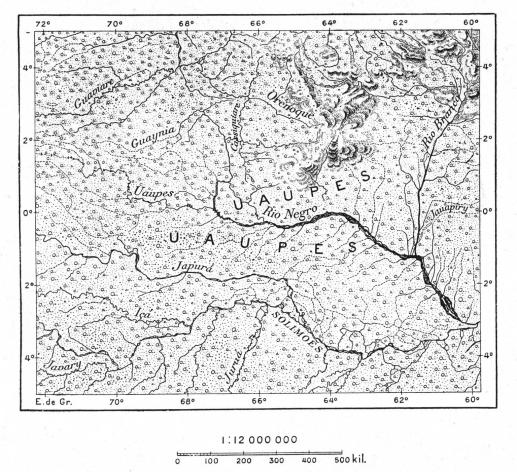
According to Coudreau, it was the uaupés women who gave rise to the legend from which the great river of South America takes its name.
Matriarchy proper, already implying a certain refinement of customs, is far superior to the ages of brute force and promiscuity, if they ever existed, as well as to the period of property possessed in common by all beneficiaries of a family group. Even at the time when the horde dragged the whole herd of children with them, the latter naturally had to group behind their genitrix and thus contribute to give her little by little the direction of the family, which happy circumstances developed into social and even political power. The father being unknown, or at least neglected as a being of adventure, the mother gathered around her home those whom she had breastfed and trained for life. Motherhood thus developed in the midst of primitive barbarism and gave the first impetus to future civilization.[7] On the coasts of South America, where family ties are very loose for most men, and where a semi-promiscuity prevails, matriarchy is organized naturally.[8]
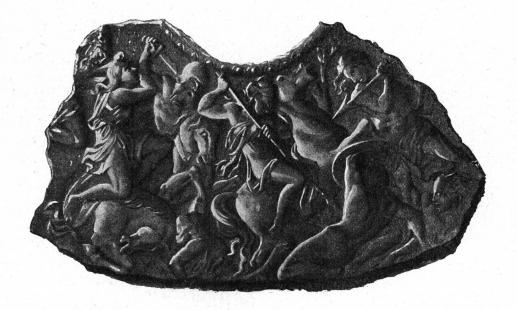
FIGHT OF THE AMAZONS
Ancient low-relief. — Fragment of a shield
(Louvre Museum)
The central influence of the child on the constitution of matriarchy remaining beyond doubt, it is certain that the action of the geographical environment must also have taken some part in this social evolution. Thus in the countries where the gathering of fruits and the search for roots were the principal means of finding food, the women, whom their functions of mothers and wet-nurses already indicated to occupy the first rank, also had other chances in their favor as providers of material life. These chances were further enhanced in regions less threatened by war, where man did not immediately rise to first place as defender or conqueror.[9] However, it is not certain that war itself always gave the supremacy to men, for the legend relating to the Amazons, in the Old World and the New World, is too general not to admit the fact of an ancient political domination of warring tribes led by women. Moreover, there is not only the legend: the examples of women who were true leaders are not lacking in history.
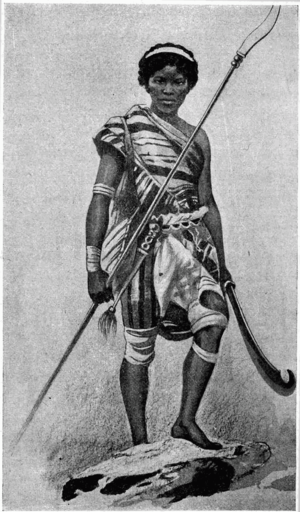
DAHOMEAN AMAZON
From a photograph
But whether or not Amazons existed as distinct political tribes, it is indisputable that various tribes absolutely recognized the supremacy of women, and that in others, men, while exercising power, still claimed to be part of the maternal family. Herodotus, in a famous passage,[10] says that the Lycians carried the name of the mother instead of that of the father, and that their condition was regulated according to that of their genitrix. The Lycian inscriptions, confirming the saying of the great historian traveler, only mention the names of the mother.[11] To the examples of matriarchy in antiquity, collected by Bachofen, Mac Lellan and numerous travelers, facts have been added of the contemporary world among non-refined populations.
To choose only a typical form of this social state, we can cite the mountain dwellers of Assam, south of Brahmaputra, the Garos and the Khasis. Even today, despite the influence of the Hindus and other populations of the patriarchal type, these tribes are divided into clans that have retained the name of mahari, that is to say "matries".{1} Related to the Tibetans, who also have remains of gynocracy, these peoples still see women as the head of the family. It is the virgin garo or khasi who offers the young man to take him for her husband; It is also she who carries out the subduction of the chosen husband, accompanied by her friends and the servants of the maternal clan. Divorce belongs to the woman: it is up to her to throw, when she pleases, five seashells in the air so that the separation is pronounced and the husband returns to his first matrie, leaving the children to the dominatrix.
Even when the man has been tolerated throughout his life, he must divorce on the day of his death: his ashes are returned to the place of his origin, while the woman is burned with honor in her matrie; later, the children's urns will be placed beside the maternal urn.[12]
By classifying all the facts relating to the formation of the primitive family in the various parts of the world, Cunow was able to clearly demonstrate that there is a close dependence between the formation of the family and the economic conditions. Thus we have never encountered frankly matriarchal institutions among pastoral peoples.
Even in the wandering hordes where descent was settled by the maternal family, as among the Ovaherero of southern Africa, before conquest ― perhaps even destruction by a colonial army from Europe ― altered their customs, the woman was far from holding the scepter: she obeyed, because wealth comes almost entirely from the man’s work. It is he who takes the beasts out to pasture, who looks after them and protects them against the enemy, against ferocious animals and marauders; it is he who milks the cows and manufactures the cheeses; he possesses at the same time strength and superiority in the economic grouping: the matriarchal vestiges of the past do not prevent the effective domination of man.
Map 35. Land of the Matriarchy
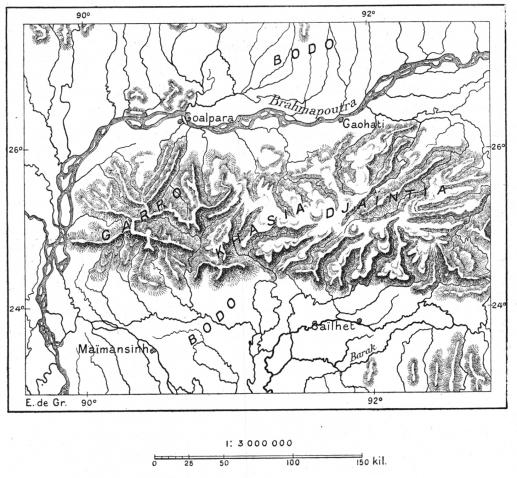
But where agriculture becomes the exclusive work of women, where husbands and sons are almost always occupied outdoors, with hunting, fishing, war, the situation is absolutely different; here the useful role par excellence, in the general economy of the tribe, belongs to the woman. Agriculture provides them with harvests more or less constant in quantity, while the products brought in by man vary according to adventures, hazards and weather. Common prosperity depends absolutely on the good management of mothers, their sense of order, the peace and concord they bring into the household. The natural affection they get from the children gathered around them develops into a kind of religion. No decision can be taken without first consulting them; absolute providers of the family wealth, they even end up becoming the regulators of all social and political affairs: the males, although the strongest, bow to moral sovereignty.
Among the Wyandots of North America,[13] the nation's grand council consisted of 44 women and 4 men, who were really only the executive agents of the female will.[14] But in more developed societies, where agriculture has assumed such relative importance that man almost completely abandons hunting and fishing to forcefully plow the furrow, the social pivot changes in the grouping of individuals, and from the great matriarchal family evolves the great patriarchal family, as we find it among the ancient Chinese, the Japanese and the Romans (H. Cunow).
Besides, the word "matriarchy" lends itself to confusion. One may readily imagine that the authority of the mother over the children implies domination in the family and at least the equality of the woman with the father; but these are very different things.
Maternal power does not at all prevent the brutality of the husband: there is, so to speak, only simplification of work in the government of the family. Thus, among the Orang Laut, who live on the Malaca peninsula, the children belong to the mother alone, which is indeed the regime of matriarchy; nevertheless the wife leads a most unhappy existence: the husband beats her and does not allow her to eat in his presence.[15]
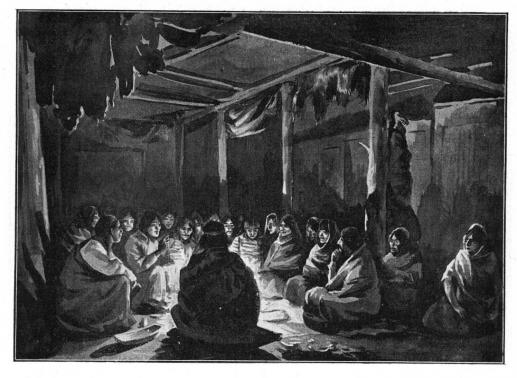
THE GREAT COUNCIL OF WOMEN, AMONG THE WYANDOTS
Drawing by George Roux from a photograph
Likewise in Béarn, as well as in Japan, the husband of an heiress, eldest of the children, will stay with her and receive from her his name, which is at the same time that of the land and which becomes that of the whole family: one could conclude from this in the existence of a true matriarchy, but the husband, whatever his deference to the heiress who gives him the fortune and the name, remains nonetheless the head, the undisputed master.[16]
Polyandry is a form of union that naturally derives from matriarchy. In the union of man and woman, the two elements have a tendency to maintain their personality anyway and consequently to take the predominance according to whether one or the other is favored by the environment. Now the woman, absolute mistress of her children, subordinating the man to her power and counting alone as will in the family, did not have to combat a hostile opinion in taking successively, or at once, several favorites: a queen, she only had to choose. But her heart being willingly faithful conservator of the first impressions, she usually acquired, even in full polyandry, the habit of maintaining family cohesion, taking as common spouses all sons of a same mother. This is the form of marriage that once prevailed in Tibet ― the land of the Bods ― and among all populations of the same origin.
Polygyny is, in the patriarchy, the institution corresponding to that of polyandry in the matriarchy. However, the contrast is not always absolute between the two types of marriages that characterize the domination of mothers and that of fathers. Thus, the example that authors like to cite as testimony of the old matriarchy nevertheless indicates the transition between the two systems: Draupadi, the wife of the five sons of Pandu, is indeed the "queen", but not the mistress of the family; although having given herself several husbands, she did not keep the government of the house, she obeyed. The patriarchal form therefore mingles, in this particular case, with the matriarchal form.
Another readily cited example is that of the Nairs of the Malayalam or Malabar coast; but in this case, too, the two regimes became intertwined. It is true: the nair women, belonging to the ancient warring and domineering nation, choose and vary their spouses, but they are bound to take them from among the Brahmins, the invading caste coming from the north, armed with science and ruse, skilled at governing while sheltering under the homage paid to an official suzerainty.
The types of these unions vary according to the greater or lesser influence of the ethnic elements represented, but all offer the character of a compromise between various institutions and are arranged in a bizarre and complicated way. Perhaps the most original example of such marriages is the collective "great union": Brahmin husbands and Nair women grouping together in societies of several individuals, even twelve per sex, of which each member, man and woman, is entitled to other members of the opposite sex.[17] This is neither matriarchy nor patriarchy, but a dual system of polygamy and polyandry, a savant return towards promiscuity, but in a strictly regulated form, between associated owners. It took a whole mixing of theological cunning and depravity to come up with such combinations. Sociological types are as intertwined as races.
Patriarchy, which, in various forms, apart from free union, has become the almost universal type of marriage in modern societies, must, like matriarchy, have its origins not only in prehistory, but also in prehumanity. The difference in environments and in evolution has necessarily given rise to quite numerous differences in detail; however, we can say, in a very general way, that matriarchy is explained by a natural fact, "the birth of the child,” and that patriarchy originates from an act of force, the abduction, the conquest, facts of historical order.[18]
It was therefore not as a result of a slow evolution, as Mac Lellan imagines, that patriarchy replaced the first matrimonial forms of the natural grouping of children, but, on the contrary, this institution stems from violent causes, from sudden events, and the evolution was quite distinct, independent, which did not prevent endless combinations and mixtures between the two types of marriages.
The origin of the first "family" in the patriarchal sense, a family very different from what we understand today by this word, was exactly the same as the origin of the State. The victorious leader seizes a country and all the inhabitants therein: he is a founder of an Empire. Each warrior belonging to the conquering band has his share of loot, land, things and men. Anyone who will obey henceforth as a slave or a concubine is part of the "family", a term which originally designated the set of goods, movable and immovable, children and servants.[19]
And the pater familias himself, the master of the family, was not originally considered as the progenitor, but only as the protector of all the little State which had fallen to him by conquest or by inheritance: the "father" can become so via a servant or a relative; until after his death, he acquires legitimate children through the institution of the "levirate" which obliges the brother to marry his deceased brother’s wife.
Besides the war, a capital fact in the founding of this first patriarchal family, the other conditions of the way of life contributed to the seizure of power by man. In groups living solely from hunting, the male carries the food to the dwelling, while the female only has to look after the children at home and take care of the household chores. It is therefore inevitable that in such a situation the father enjoys the greatest authority: a god, provider of the flesh and blood, he can imagine that he has some right to worship from his family. Among nomadic peoples, the males, being the strongest, have to capture, tame and kill the cattle; they also take all rights over the weaker women, designated by nature for the preparation of meals, for the care of the man’s children and the offspring of the beast. Patriarchy, all other things being equal, must therefore become particularly worse among these pastors, especially when they are at the same time warriors and seek to enslave other populations. Each new batch of captives reacts on the family of the victor and diminishes the rights of the wife in proportion.
As a result of the struggle between the two principles, one deriving from the natural solidarity between the child and the mother, the other from the violence exerted by male captors, the two types of marriage, matriarchy and patriarchy, have developed side by side in the series of ages and according to the vicissitudes of men, taking or losing in relative force, without ever keeping as an institution the point of equilibrium, which is the perfect equality of rights between the individuals, and therefore between the sexes.
However, in Sumatra, the three forms of marriage were clearly recognized: the jugur, by which the man bought the wife; the ambel-anak, by which the woman bought the man, and the semando or household of equals.[20]
Likewise among the Hassaniyeh and the Hamites of the Upper Nile, it is often recognized to the married woman her share in the products of culture. In the continuing antagonism of regimes, the patriarchy is, as history shows us, the one that most often prevailed, given the difficulties of the struggle for existence, which requires the employment of force, and the result of the conflicts that occur in the families themselves.
The interweaving of traditions and ideas shows that everywhere, even among essentially patriarchal populations, there are still some remains of the old matriarchy, sometimes very bizarre, as among the Baluba of Kasai, where women are true slaves, acquired with money, but where they nevertheless preside as "elders" ["anciennes"] to the blessing of sowing.[21] Elsewhere, especially in Berber societies, the woman, a serve herself, nonetheless protects the foreigner, like a divinity. Likewise, in our Middle Ages, the hand of a woman replaced the touch of an altar. The traces of it have become so weak in modern societies, founded on the rights of the husband or the father, that virtue itself, virtus, was formerly considered as monopoly of the male.[22] And naturally this exclusive claim to virtue must have engendered all the evils: ferocious jealousy of the proprietary husband, brutality in the education of children, burning of widows, the practice and ultimately the duty of infanticide.
We know what happened to certain regions of the warring India under this regime. Even in the course of our very recent civilizations, right up to the "Age of Enlightenment", have we not seen Rajputs or "Sons of Kings", these types of traditional honor, invariably marrying by way of kidnapping, letting their mothers burn at the paternal stake, and almost always killing their daughters, for fear of not being able to marry them with enough wealth and splendor?
We see, in this case, how much the social grouping formed by the clan, tribe or nation and consolidated by traditional morality has more influence than the natural feelings manifested in marriage and in kinship. These affections, these personal conveniences have to adapt to conventions dictated by public opinion or are ruthlessly dismissed. The common will of the group is imposed by dictatorship, and all the more powerfully as the tradition is of longer origin and less reasoned: "This is how it has always been done!" There would therefore be a rapid death of any association for lack of renewal if the vicissitudes of life were not in charge of modifying the groupings by crossed associations or violent disruptions.
[…]
[1] Transactions of the Royal Historical Society, vol. VI, 1892, page 97.
[2] Max Müller, Essais de Mythologie comparée, trad. de G. Perrot, page 307.
[3] Mac Lellan, Primitive Marriage.
[4] Guyau, Morale d’Épicure, page 160.
[5] Bachofen, Mutterrecht.
[6] Heinrich Cunow, Bases économiques du Matriarcat (Devenir social, janvier 1898).
[7] Élie Reclus, République française, 23 fév. 1877.
[8] Liard-Courtois, Après le Bagne, p. 117.
[9] Ernst Grosse, Die Anfänge der Kunst, p. 36.
[10] Livre I, 173.
[11] Bachofen, Mutterrecht ; M. Kowalewsky, Tableau des Origines et des Évolutions de la Famille et de la Propriété.
[12] Dalton, Ethnology of Bengal.
[13] Heinrich Cunow, Le Devenir social, avril 1898, pp. 335 à 341.
[14] J.W. Powell, Wyandot Government.
[15] Laloy, Anthropologie, t. viii, 1897, p. 110.
[16] Jacques Lourbet, Revue de Morale sociale, 1899. p. 164.
[17] Mac Lellan, Primitive Marriage.
[18] Ludwig Gumplowicz, New deutsche Rundschau, vol. 1, 1895, p. 1143 et suiv.
[19] Michel Bréal et Anatole Bailly. Dictionnaire étymologique latin.
[20] Lubbock, Origines de la Civilisation.
[21] Garmijn, Bulletin de la Société belge de Géographie, nov. 1905.
[22] G. de Greef. Le Transformisme social.
{1} Matrie in French, being the feminine equivalent of patrie, means "motherland" in the sense of "homeland". (Translator)